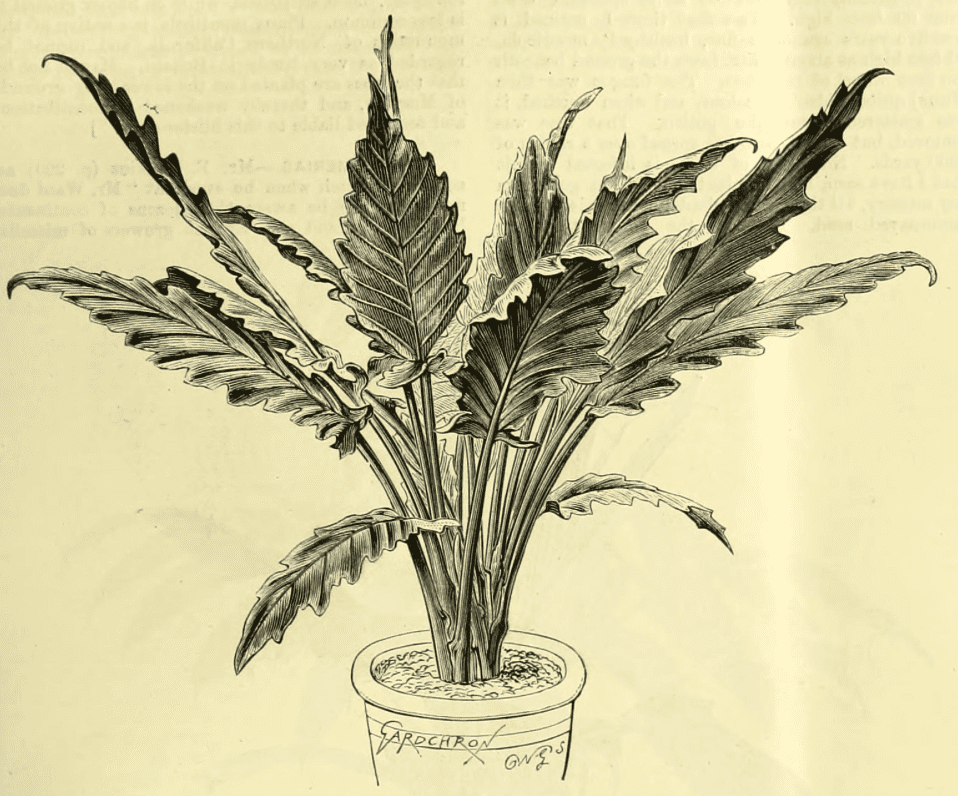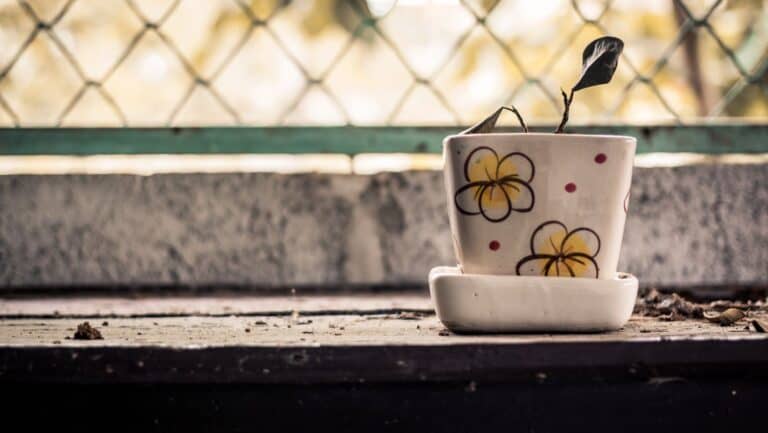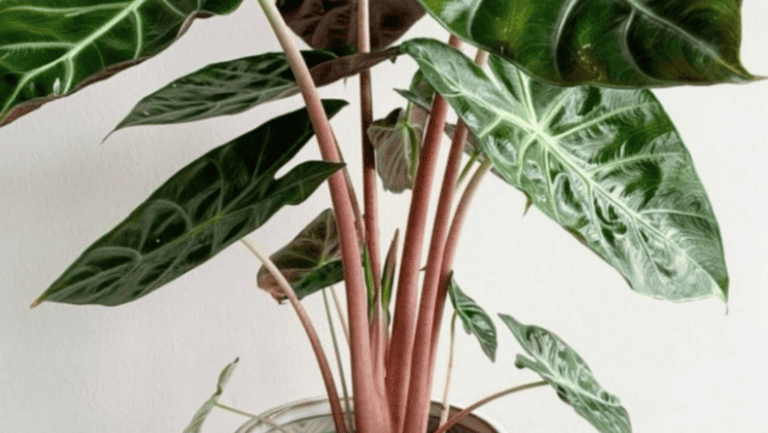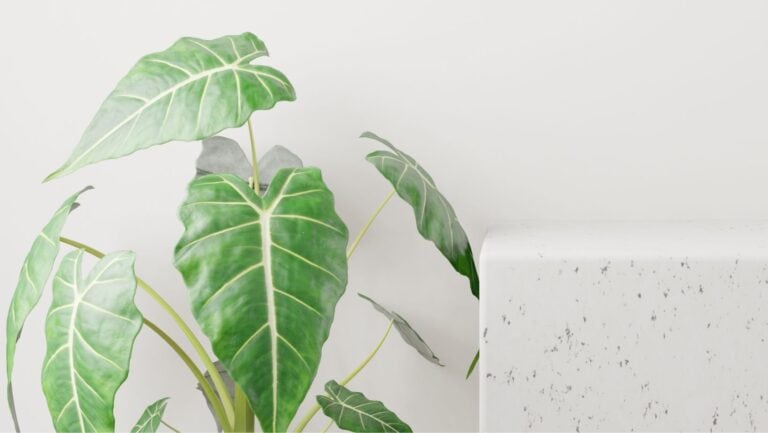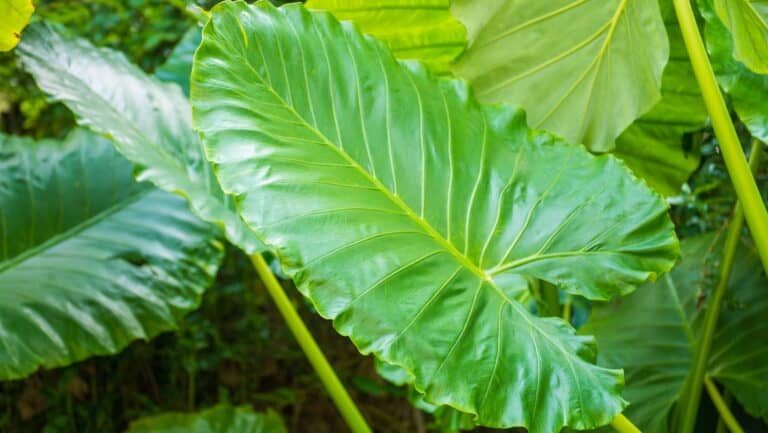Alocasia With Long Leaves: Alocasia Purple Sword and Her Relatives
If you are trying to find an Alocasia with stunning long leaves, whose name you cannot remember, chances are the elusive beauty is Alocasia Lauterbachiana.
It is true that in the big and diverse family of Alocasia plants, shield and arrowhead leaf shapes are more common than sword-shaped foliage. Yet, Alocasia lauterbachiana is not the one and only Alocasia with long leaves.
In this article we’ll have a closer look at the beautiful Alocasia Lauterbachiana ‘Purple Sword’ and meet some of her lesser-known relatives with long leaves.
Alocasia Lauterbachiana (a.k.a. Purple/Silver Sword)
Alocasia lauterbachiana has a lot to make heads turn. Her foliage is truly remarkable, with long leaves featuring beautifully cut, undulating edges and a deep bronze-green color with a purple underside. This is why it is sometimes called the ‘Purple Sword’ (and occasionally the ‘Silver Sword’).
My personal journey with Alocasia started with Alocasia lauterbachiana. I just could not pass by her in a local nursery. Regretfully, this first story was a short one. Very quickly she got spider mites and in spite all my efforts she gradually lost all the leaves and I considered her dead. It was before I got to know these plants better. Today, I would not toss away an Alocasia just because she lost all her leaves (more on that in this article). Yet, this first plant got me curious about origins and habits of Alocasia.
Where Does Alocasia Lauterbachiana Come From?

This beauty came to us from New Guinea and Bismarck Archipelago, where she has some other long-leaf relatives.
The plant owes its not-easy-to-remember name to German biologist and explorer of New Guinea, Carl Adolf Georg Lauterbach. During his expeditions to the region, he gathered rich botanical collections, including specimen #632 collected in the forest near Sattelberg mountain. This specimen was then described as a new species by another prominent German biologist, Adolf Engler, and given the name Schizocasia Lauterbachiana. Later, it was redefined as Xenophya Lauterbachiana before the Xenophya genus was finally reduced to a group of Alocasia. This species became known as Alocasia Lauterbachiana. That’s the long story of the long name.
How to Care for Alocasia Lauterbachiana?
In the wild, Alocasia Lauterbachiana is typically found in the lowlands of rainforests, particularly near river edges and forest edges. What does this tell us about her habits? First of all, she thrives in warm and humid environments, just like almost any tropical plant. While she won’t appreciate direct sunlight, she clearly prefers more open areas of rainforests where light is filtered but abundant.
Second, the soil and watering. Lowland forest of New Guinea that Alocasia Lauterbachiana calls home develops best on relatively well drained soils. Yet, with the high amount of rainfall the soils never fully dry out. Thus, to make this beauty happy it’s recommended to keep the soil consistently moist but not waterlogged.
Another thing to note is that in the wild, this plant is constantly growing, but its leaves are short-lived, which means they only last for several months. Therefore, don’t panic if the lower leaves of your Alocasia Purple Sword are gradually turning yellow and dying out, as long as the new ones keep growing. With good care, the number of leaves on the plant at any one time (in the wild, it’s around six) may be higher. On the other hand, less favorable conditions in winter might slow down the growth, and your plant may lose all of its leaves. In this case, check the rhizome, and if it is nice and firm, treat it as a dormant plant. Leave it in soil and water moderately. Chances are it will wake up as if nothing happened when the days get longer and warmer.
Other Long-Leaf Alocasia That ‘You May Also Like’
While long leaves are a rare feature in the Alocasia family, Alocasia Lauterbachiana is not the only plant that exhibits this trait. As mentioned earlier, this long-leaved beauty belongs to the Xenophya group, which is endemic to the Moluccas, New Guinea, and the Bismarck Archipelago. Alocasia plants in this group are characterised by long-sheathed leaves. In this article, we will look at four of them in the order of decreasing rarity in commercial distribution.
Alocasia Boa
Alocasia Boa is a cousin of Alocasia Lauterbachiana that can also boast long, beautifully-cut leaves. It is not as readily available as its relative in plant nurseries, despite having been in cultivation for a long time – earlier, it was commercialized under the name ‘Xenophya Frenchville’.

It is not the long leaves that gave the name to this plant. In fact, her leaves are about as long as those of Alocasia Lauterbachiana (up to about 60 cm), but are wider — to 27 cm vs. 15 cm for Alocasia Lauterbachiana. The name is due to the serpentine-like spathe in her flower.
Alocasia Boa is not as rich in color as the Purple Sword, even though her petioles are nicely mottled with pinkish and chocolate colors. The leaves are plain green on both sides. What adds some points to her looks are the leaf margins with zigzagging indentations.
Alocasia Boa has the same habits as Alocasia Lauterbachiana, preferring warm and humid environment under the canopy of lowland rainforest in Papua New Guinea.
Alocasia Lancifolia
Another long-leaved Alocasia from the Xenophya group is Alocasia Lancifolia, whose name accurately describes the lance-like shape of its leaves. This plant is even more challenging to find in commercial distribution than Alocasia Boa, despite being widespread in the New Guinea lowlands.

This plant is usually smaller than her cousins described above. She has shorter petioles and glossy, green, leathery leaves without indentation on the edges.
Alocasia Lancifolia’s long leaves could be a form of adaptation to her preferred habitat, which includes open swampy areas and forest streams. This species thrives in water-rich environments and enjoys moist soil.
The other two relatives of Alocasia Lauterbachiana are not commonly found in plant nurseries but can be observed in botanical gardens or during a hike through the tropical forests of Papua New Guinea.
Alocasia Hollrunghii
The first of the two rare birds is Alocasia Hollrunghii, whose difficult-to-remember name commemorates another German botanist, Udo Max Hollrung, who participated in a research expedition to New Guinea in the period from 1886 to 1888. While rare in cultivation, this plant is widespread in the lowlands of Papua New Guinea and can even appear as an abundant weed in plantations.
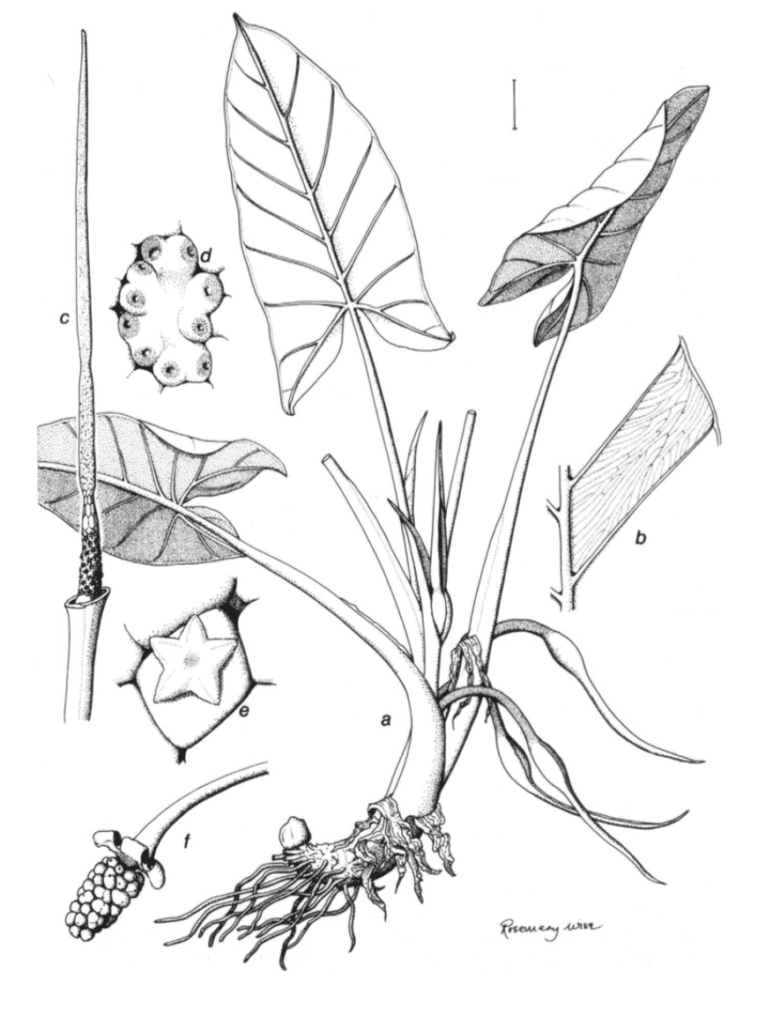
Alocasia Hollrunghii is characterized by highly variable leaf shapes, but most often her leathery leaves resemble an elongated arrowhead, sometimes with a slightly undulating margin. While the leaf color is typically mid-green, her petioles can be quite remarkable, ranging from green to bronze, rarely purple-black, and sometimes pinkish-mottled.
Alocasia Monticola

Alocasia Monticola is, as her name suggests, a mountaineer. As opposed to her relatives from the Xenophya group, this beauty prefers lower montane forests to lowlands. Yet, she also likes damp sites.
Her leaves are smaller, usually no longer than 30 cm long and 10 cm wide, and are characterised by prominent often purple veins.
The leaves are held horizontally, contrary to the cousins with more or less vertically held leaves.
SOURCES:
- Hay, A. & Wise, R. (1991). The genus Alocasia (Araceae) in Australasia. Blumea 35: 499–545.
- Engler, A. & Krause, K. (1920). Araceae-Colocasioideae. Pflanzenreich 4 (23C).
- Nicolson, D.H. (1968). The genus Xenophya Schott (Araceae). Blumea 16: 115-118.

